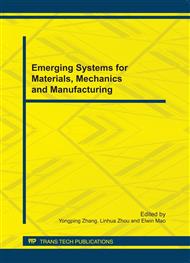p.504
p.509
p.517
p.523
p.528
p.532
p.537
p.541
p.547
A New PRI Transform for the Deinterleaving of Radar Pulses
Abstract:
This paper presents a new algorithm for the deinterleaving of radar signals, using the direction of arrival (DOA), carrier frequency (RF), and time of arrival (TOA). The algorithm is mainly applied to pulse repetition interval (PRI) signals. This algorithm consists of two steps: In the first step, a PRI transformation is used to the received pulses after pre-deinterleaved of frequency and DOA. In this step, radar signals having the same frequency and DOA are identified as the same class. In the second step, the number of existing emitters and their PRIs is determined by using TOA information. The algorithm for deinterleaving uses the information obtained from the previous analysis to reduce the PRI errors. The simulation results show that the algorithm is successful in high pulse density environments and for the complex signal types.
Info:
Periodical:
Pages:
528-531
Citation:
Online since:
October 2011
Authors:
Keywords:
Price:
Сopyright:
© 2012 Trans Tech Publications Ltd. All Rights Reserved
Share:
Citation:


